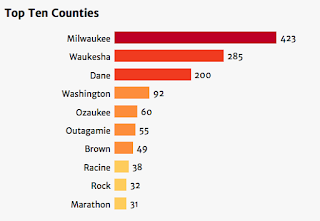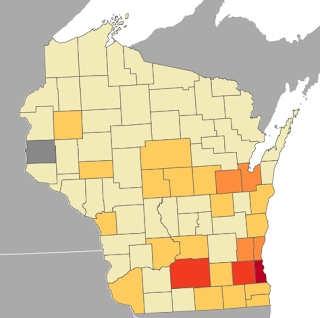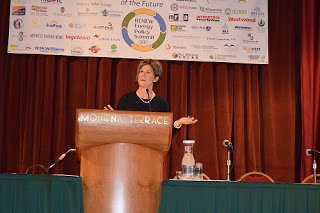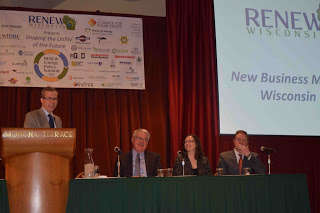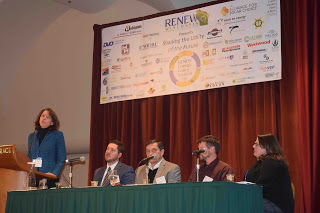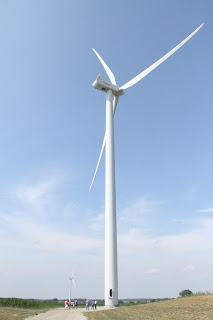
by jboullion | Mar 14, 2016 | Uncategorized
 |
| Glacier Hills Wind Project |
A new wind power project looms on the horizon for 2017. If built it will be the first large wind generation to go up in Wisconsin project since Glacier Hills in Columbia
County. All told, nearly 50 wind turbines could be built and placed in
service in Lafayette County east of Platteville, according to Vanessa
Tutos, government affairs director for project developer EDP Renewables.
The project enjoys strong support from local landowners.
Media coverage of the new wind project:
“New wind farm coming to Lafayette County brings boost to WI wind energy industry”
http://www.wkow.com/story/31459659/2016/03/13/new-wind-farm-coming-to-lafayette-county-brings-boost-to-wi-wind-energy-industry
“Wind farm drought may nearing end in Wisconsin”
http://www.jsonline.com/business/wind-powers-wisconsin-dry-spell-may-be-ending-b99683088z1-371880561.html
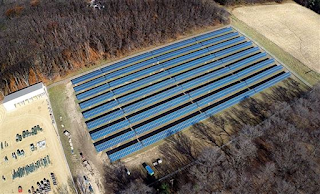
by jboullion | Mar 11, 2016 | Uncategorized
More information
Tyler Huebner, Executive Director
608-575-2201 (cell)
tyler.huebner@renewwisconsin.org
PSC Approves Madison Gas & Electric Community Solar
 |
Eau Claire Electric Cooperative’s 2015
872 kW Community Solar Array |
Madison, WI – March 11, 2016
Today, the Public Service Commission of Wisconsin, which regulates the state’s utilities, approved a Community Solar project for Madison Gas & Electric (MGE). “Community solar” is a single, larger solar project in which a large number of people collectively share in the cost to build the project and share in the benefits of the solar energy production. The MGE project will be 500 kilowatts and will be placed on the roof of the Middleton Operations Center in Middleton, WI. MGE estimates that 250 people will participate in this project.
MGE joins a host of other electric providers offering community solar in Wisconsin, but this project differs from the others in two key ways:
– Participants will pay a small up-front fee of 10% of the cost per solar panel, as opposed to paying the entire fee for a panel at once
– Participants will then pay a 12 cents per kilowatt-hour rate for the solar energy generated by the Middleton array for up to 25 years. This is higher than today’s energy-only rate. But standard electric rates are expected to rise over time and exceed the 12 cent energy-only rate in about 10 years, meaning customers will start saving money at that point. (Both standard rates and the solar rate will also see 3-4 cents per kilowatt-hour in distribution charges.)
MGE structured its program differently because it has different customer demographics and looked for a program option that would not require a large up-front fee.
“Solar energy development improves Wisconsin because it creates jobs and increases local, secure, and clean energy,” said Tyler Huebner, RENEW Wisconsin’s Executive Director. “Adding options for more customers to participate in solar is a smart business move for MGE. Nearly 90% of Wisconsinites want more solar power, but only about 1 in 4 customers can put solar on their own property. Community solar programs like this enable many more citizens to participate in building a clean energy economy. We congratulate MGE on gaining approval for this novel community solar program design, and we hope it is successful.”
MGE’s application and supplemental responses are available in Docket 3270-TE-101 at the PSC’s website, http://psc.wi.gov/.
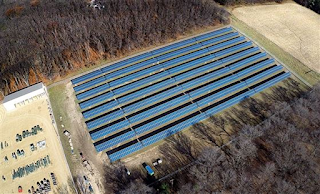
by jboullion | Mar 10, 2016 | Uncategorized
Will Dane County see its first community solar project? That all depends on the Public Service Commission’s decision on Madison Gas & Electric’s application to build a 500 kilowatt array on a brand new building owned by the City of Middleton. The PSC will decide tomorrow, March 11.
Below is an article from today’s Isthmus written by Cara Lombardo on the proposed MG&E project.
Keep on the sunny side
 |
Eau Claire Electric Cooperative 2015
872 kW Community Solar Installation |
Adam Gusse, vice president of H&H Solar in Madison, hopes his employees can start putting solar panels on the roof of Middleton’s Municipal Operations Center this June. Construction would take a month and a half and result in a solar panel array that would provide 500 kilowatts of power to up to 250 homes currently served by Madison Gas and Electric.
The project just needs approval from the Public Service Commission.
MGE expects the PSC to rule on its proposal for a solar energy pilot program by the end of the month. While community solar projects have cropped up across the state, MGE’s project would not only be the first in Dane County but also the first south of the Wisconsin Dells.
Bradley Klein, an attorney at the Environmental Law and Policy Center in Chicago, says Wisconsin has lagged neighboring states when it comes to adopting solar energy. Minnesota, in particular, is already operating community solar projects on a large scale.
“In Wisconsin, for one reason or another, it’s been hard to get the commission excited about this in the way that we’re seeing in many other states across the country,” he says.
But Klein says the MGE proposal is “a good sign” for the state, and that creating strong, stable policy to help the market grow should be a priority.
Few utilities were prepared to invest in solar energy until the price dropped by 60% over the past four years, which is driving utilities to consider owning solar themselves.
Michael Vickerman, program and policy director at RENEW Wisconsin, an organization that advocates for renewable energy, says MGE is very interested in solar energy. “What they would really like to do is just start building solar,” he says. “But right now, the PSC’s position is, ‘Utilities don’t need more generating capacity.’ If there’s no need for these arrays, then the next thing they’d look at is, if a utility goes ahead and builds them, will this add costs to other ratepayers? That’s the lens through which they look at these very modest proposals from investor-owned utilities.”
RENEW Wisconsin commends electric providers who are trying to offer a choice despite what Vickerman calls a “vacuum of policy” in Wisconsin with respect to the environmental and economic benefits of solar energy. Because the benefits haven’t received proper consideration, he says, people who want solar energy will have to pay a little more, at least initially.
Community solar allows customers to source solar energy from centralized solar panel arrays instead of having to install panels on their homes. More than half of homes are unfit for solar panels, either because the roof is shaded or not properly oriented, and community solar allows for much larger arrays.
Customers who choose to participate in community solar arrangements typically pay an initial subscription fee, which can be a few thousand dollars depending on the investment size, to fund construction. Each month, the project’s energy output is measured, and customers receive reductions on their bills based on the amount of energy generated from their shares of the array. It usually takes more than 10 years for monthly discounts to cover the initial investment. But for many, it’s an easy way to support clean energy.
MGE’s proposed project is slightly different: Instead of selling shares of the array, MGE would own it and sell customers shares of the array’s output. Under this arrangement, smaller investments would be possible, and upfront costs would be significantly lower, around $380 for an average household subscription of 2 kilowatts.
Participants would pay a level rate of $0.12 per kilowatt-hour for energy produced from the panels; the default rate is around $0.095 per kilowatt-hour. However, the solar rate would be locked in for 25 years.
Eight community solar projects currently exist in the state, six of which are rural co-ops not regulated by the PSC. Dairyland Power Cooperative, which is based in La Crosse, and Xcel Energy have both announced plans for solar projects that would nearly double the capacity of solar energy in the state.
Gusse says the project, if approved, will build on the growth of solar energy in the state and generate even more interest: “It will be exciting to see if it gets through the approval process.”
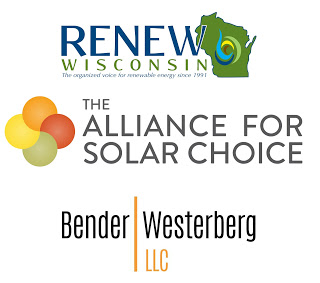
by jboullion | Mar 3, 2016 | Uncategorized
RENEW Wisconsin’s advocacy has once again made the difference for a renewable energy victory.
The Public Service Commission of Wisconsin, the state agency that regulates electric utilities, and We Energies have decided not to appeal our October 2015 Circuit Court victory. RENEW Wisconsin partnered with The Alliance for Solar Choice, a national solar energy advocacy association, on this lawsuit. David Bender of Bender Westerberg LLC represented both groups in this matter.
 The October 2015 Circuit Court decision struck down a new charge that most customers who generate their own power, whether through solar panels, small wind, biogas, hydropower, or other sources, would have faced starting in 2016.
The October 2015 Circuit Court decision struck down a new charge that most customers who generate their own power, whether through solar panels, small wind, biogas, hydropower, or other sources, would have faced starting in 2016.
The PSC or We Energies could have appealed that Circuit Court ruling, but they have chosen not to. That means We Energies’ new net metering service approved in 2014 will take effect, but without the PSC-approved “capacity demand charge” that would have reduced savings from newly installed residential solar systems by 30%.
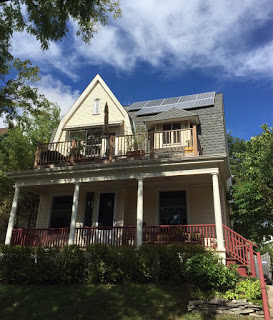 |
| Halvorsen Home Solar Installation in Milwaukee, WI |
In addition, the new net metering service sets a much higher cap for project sizes that can participate in the net metering program. The cap is now set at 300 kilowatts (kW) of AC power.
The previous cap was 20 kW, which RENEW had challenged in court following We Energies’ 2012 rate case. The 300 kW ceiling for net metered systems was proposed in 2014 by We Energies in response to our previous Circuit Court victory.
All told, our two court victories have added up to the following net metering service terms:
– Project size up to 300 kW AC, the highest cap allowed by any utility in Wisconsin
– Monthly “netting” of consumption vs. production (RENEW advocated for annual netting but did not win this point from the PSC in 2014)
– No extra charge imposed on customer-generators
We Energies typically files a new rate case every two years. If that trend continues, its next rate filing would come in Summer 2016. You can count on us to prepare for that filing along with others proposing changes to rates and distributed generation services.
Stay tuned!!

by jboullion | Feb 24, 2016 | Uncategorized
More information
Tyler Huebner, Executive Director
608-575-2201 (cell)
tyler.huebner@renewwisconsin.org
RENEW Wisconsin Applauds Dairyland Power Cooperative’s Solar Energy Leadership
 |
Overhead shot of Eau Claire Energy Cooperative’s
2015 865 kW Community Solar Project in Fall Creek, WI |
Madison, WI – Feb. 24, 2016
Today, Dairyland Power Cooperative announced that it is contracting to build 12 solar projects throughout western Wisconsin which will provide 15.5 megawatts of solar power capacity.
The projects will provide enough energy to power over 2,500 homes, according to Dairyland Power.
“We congratulate Dairyland Power Cooperative’s leadership in advancing solar energy in the State of Wisconsin,” said Tyler Huebner, Executive Director of RENEW Wisconsin.
“Wisconsin is coming off its best year ever for solar power, with 7.5 megawatts installed in 2015, three times more than any prior year. Dairyland’s announcement ensures that 2016 will surpass that and become Wisconsin’s biggest year ever for solar. In fact, it’s quite possible that the amount of solar generation coming online in 2016 alone may double the 25 megawatts already in place when the year began,” added Huebner.
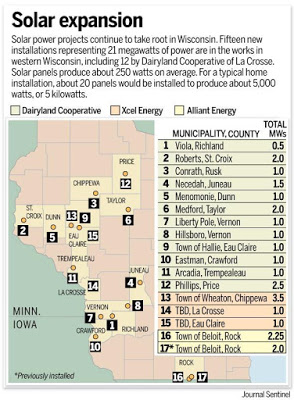 |
| Map from Milwaukee Journal Sentinel |
Other utility solar projects previously announced expected to come online in 2016 include:
– Alliant Energy & Hanwha Q Cells USA – 2.25 megawatts in the Town of Beloit
– Xcel Energy – 3.5 megawatts near Chippewa Valley Airport
– Xcel Energy – 2 megawatts of community solar projects in western Wisconsin
The Xcel Energy community solar projects were also announced Wednesday, and will be the largest community solar arrays in Wisconsin. Madison Gas & Electric has also filed with the Public Service Commission to build a 0.5 megawatt project.
“We also applaud Xcel Energy’s announcement to continue the momentum of community solar arrays in Western Wisconsin. With the cost of solar projects down 60% in the past six years, utilities, businesses, and average citizens alike are taking advantage of affordable and clean solar power,” added Huebner.
Media coverage of the announcements:
– Milwaukee Journal Sentinel
– La Crosse Tribune
by jboullion | Feb 11, 2016 | Uncategorized
On Tuesday, February 10th, 2016, RENEW Wisconsin gave the below comments on AB 804, a bill that proposes to cut $7 million from the Focus on Energy program.
Comments of RENEW Wisconsin
To Joint Finance Committee
AB 804 – Public Service Commission Reform Bill
February 10, 2016, 10 AM Hearing
My name is Tyler Huebner, and I am the Executive Director of RENEW Wisconsin. RENEW Wisconsin is a membership-based organization that represents over 400 individuals and over 50 businesses in the renewable energy industry in Wisconsin.
Thank you for the opportunity to appear today. My comments today are confined to the Focus on Energy funding portion of this bill.
1. The Focus on Energy Program has historically been, and continues to be, an unqualified success for the state of Wisconsin’s citizens, businesses, and economy.
The latest evaluation report shows that in 2014, $3.33 in energy-related benefits were provided for every $1 invested in the program. These annual evaluations are conducted by an independent company.
When economic benefits such as job creation and dollar flows through the Wisconsin economy are included, the program returns double that: over $6.60 per dollar invested in the Focus on Energy Program.
2. Wisconsin’s electricity rates are now THE HIGHEST in the Midwest, according to the federal Energy Information Administration. Businesses and homeowners need programs like Focus on Energy to be able to control their energy bills.
Our electricity rates have increased steadily in Wisconsin over the past 15 years. From 2000 to 2012, Wisconsin’s average electricity rate increases were the third highest in the whole country – an increase of 80%.
There is very little that the average Wisconsin citizen or business can do to reverse that trend.
Therefore, having voluntary options for reducing energy bills are critical in this time of continuously rising electric rates. This is true for homeowners trying to manage their monthly budgets, and even more critical for our businesses who are competing in the marketplace.As one example, Letterhead Press, Inc., is a specialty printing company based in New Berlin. Recently Letterhead Press used the Focus on Energy program incentives for solar PV to install a large solar installation at their printing facility that would create about 25% of their electricity needs. The major driving philosophical reason for pursuing this project was, by their calculations, that their electric rates had increased 75% since the year 2000.
Feeling as though those continuously increasing rates were challenging their global competitiveness, the company started investigating ways they could lock in lower electric rates. They landed on a solar PV installation, which the Focus on Energy program incentives enabled to get the payback down to a level where this business was willing to invest in the project, as compared to other Return-on-Investments the company could make in its business investments.
As rates continue to increase, it is voluntary programs like Focus on Energy that enable businesses who are striving to be competitive to stay competitive, and residents to continue to have energy and dollar saving options to afford the basic benefit of electricity.
3. Investing in Focus on Energy SAVES all ratepayers by delaying expenses for large power plants
Although all customers pay into the program, in reality all customers benefit far beyond what they pay in. Without Focus on Energy, Wisconsin utilities would need to make larger investments in power plants that will ultimately cost all ratepayers more.
Conclusion:
The Focus on Energy program is an unqualified success for Wisconsin’s energy policy and utility customers.
We urge you to find a solution that does not reduce the funding and effectiveness of the Focus on Energy program, specifically to amend this bill so that the $7 million is not cut out of the Focus on Energy budget.
Sincerely,
Tyler Huebner
Executive Director
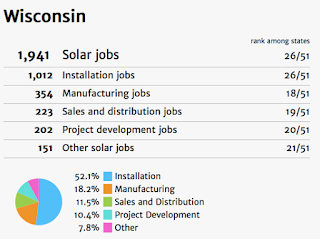
by jboullion | Feb 10, 2016 | Uncategorized
Immediate release
February 10, 2016
More information
Tyler Huebner, Executive Director
608.255.4044 x 1
tyler.huebner@renewwisconsin.org
Wisconsin Solar Industry Employs Over 1,900
Today, The Solar Foundation released the state-by-state results of its annual “Solar Jobs Census.”
Wisconsin’s solar industry employs 1,941 workers according to the Census, across installation, manufacturing, sales and distribution, project development, and related sector employment. That places Wisconsin 26th nationally for the number of solar jobs in the state, and 27th nationally in solar jobs per capita.
The full state-by-state report can be found at http://solarstates.org/, where there is a national map and each state’s data can be accessed.
Milwaukee, Waukesha, and Dane Counties are the three counties with the largest number of solar jobs. Installation jobs account for over half of the total in Wisconsin.
Nationally, the industry grew again at a 20% clip to over 208,000 workers. The report shows there are now three times as many solar workers nationally as coal workers.
“Solar energy is a job-creation engine,” said Tyler Huebner, RENEW Wisconsin’s Executive Director. “While Wisconsin’s solar industry employment is holding steady, nationally, the solar industry grew by 20% for the third straight year. In Wisconsin we are not fully harnessing solar energy’s job creation and economic development opportunities to move Wisconsin forward.”
“Wisconsin’s economy will benefit from improved rules and regulations to unlock solar energy’s true potential – rules like better net metering policies, clarifying third-party ownership (solar leasing), and interconnection policies that govern how simple it is for a home or business to connect solar to the local utility grid,” said Huebner.
The Solar Foundation report shows that Wisconsin gets a “D” grade for both net metering – a policy that determines how a customer is credited for extra energy they produce and put on the local electric grid – and interconnection policies.
Selected images from the Wisconsin page of http://solarstates.org appear below:

by jboullion | Feb 10, 2016 | Uncategorized
 Registration is now open for a Coulee Region solar energy seminar at Western Technical College (WTC) on March 1st. 7 Rivers Alliance, a La Crosse-based economic
Registration is now open for a Coulee Region solar energy seminar at Western Technical College (WTC) on March 1st. 7 Rivers Alliance, a La Crosse-based economic
development organization, will host this half-day forum in partnership
with WTC, Dairyland Power Cooperative, and Xcel Energy.
Targeting Coulee Region community and business leaders, the seminar will bring together energy professionals from the area to discuss best practices in developing both customer-sited solar systems as well as community-scale projects. John Farrell, director of the Economic Democracy Initiative at the Institute for Local Self-Reliance in Minneapolis, will be the featured speaker.
Where: Lunda Center, Western Technical College, La Crosse
When: March 1, 2016, 9:00 AM – 12:30 PM
For program and registration information, visit their website here.
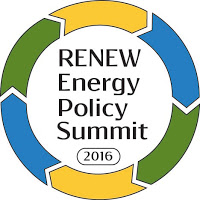
by jboullion | Jan 28, 2016 | Uncategorized
“Shaping the Utility of the Future,” our fifth Annual Renewable Energy Policy Summit, was another huge success for the organization. Held January 21, 2016, it featured thought and action leaders from across the country and leaders from Wisconsin’s utilities and renewable energy industry
The event covered the gamut of opportunities and challenges for increasing renewable energy in Wisconsin. From both the number of attendees, and their feedback so far, we had the best Summit yet!
– 295 registered
– 265 attended
– 56 business and organizational sponsors
– 17 exhibitors
Following some opening remarks from RENEW’s Board President, Carl Siegrist, U.S. Congressman
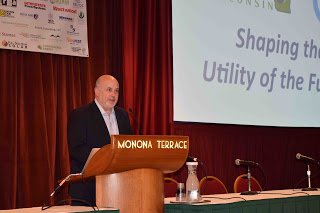 Mark Pocan
Mark Pocan gave our audience a warm welcome to Madison, and spoke about the job creation potential of renewable energy and his leadership in Washington, D.C.RENEW’s Tyler Huebner gave a review of 2015’s renewable energy policy impacts and a brief look forward to 2016’s top priorities. Then, we handed the stage over to our opening keynote speaker.
Mary Powell, CEO of Green Mountain Power: “The Energy Company of the Future”
Mary started her speech with her own personal story. She grew up thinking she would become an artist, with no thought that she would ever become an executive. She then transitioned into the evolution that she brought to Green Mountain Power, first starting with a cultural change. She moved the executives out of an office building and into a converted maintenance building next to the line workers.
That lead to the transition in the electricity side of the business. Mary’s business background outside of the utility industry taught her that the customer is king, and Green Mountain Power’s customer surveys showed customers wanted low cost energy, and more renewables. Bucking the traditional thinking that low cost and renewables don’t go together, she challenged her team to figure out how to deliver what their customers want.
The GMP result is “stacking the benefits” as Mary calls it – finding ways to aggregate all the benefits of distributed generation in a way that can lower costs for everyone. You can learn more about how Green Mountain Power is incorporating renewable and distributed energy, click here.
New Business Models & Policy Impacts: Wisconsin Utility Perspectives
Brian Rude of Dairyland Power, Deborah Erwin of Xcel Energy, and Kevin Westhuis of River Falls comprised representatives of cooperative, investor-owned, and municipal electricity providers for our utility panel.
Moderated by Eric Callisto of Michael Best & Friedrich law firm, the panelists discussed their community solar initiatives and additional renewable projects outlook. They also discussed the key policy issues at hand: the U.S. EPA’s Clean Power Plan, distributed generation, the future of the state’s renewable portfolio standard (or RPS).
Awards & Recognition Ceremony
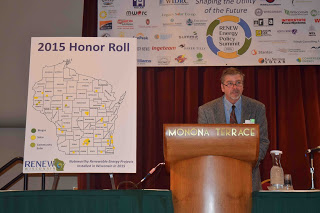 Over lunch, RENEW’s Michael Vickerman lead the recognition of over 40 of 2015’s best renewable energy projects. Three categories were recognized:
Over lunch, RENEW’s Michael Vickerman lead the recognition of over 40 of 2015’s best renewable energy projects. Three categories were recognized:
– Community solar, featuring five electricity providers who installed community solar programs in 2015
– 30 Largest projects, featuring 29 solar and 1 biogas project, the largest renewable energy systems installed in 2015
– “10 to Remember,” highlighting unique partnerships and stories of ten solar installations, from large businesses to community solar to non-profit donation-led models.
James Tong, Spruce Finance, “The Democratization of Energy and the Networked Grid”
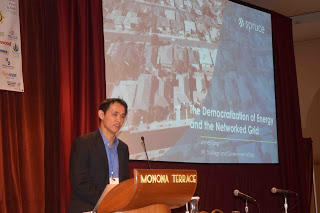 James Tong came into the renewable energy space trying to figure out how to increase solar installations. He came to the conclusion that working with utilities, and sharing both the utilities natural advantages and the solar industries advantages together, will lead to the most solar at the lowest cost.
James Tong came into the renewable energy space trying to figure out how to increase solar installations. He came to the conclusion that working with utilities, and sharing both the utilities natural advantages and the solar industries advantages together, will lead to the most solar at the lowest cost.
After realizing that many utilities will have a hard time making the evolution into solar, for both business and regulatory reasons, he has set out to establish a more democratized electricity grid that would enable market-based transactions for distributed resources. That grid would behave much like the Apple “App Store,” with the utility owning and maintaining the grid as a platform, where valuable third-party providers could provide services. View James’ PowerPoint here.
Driving Markets: Perspectives from the Renewable Energy Industry (presented by S.C. Johnson)
Our day’s final panel featured experts from three critical renewable energy technologies:
– Chris Kunkle, Wind on the Wires
– Steve Dvorak, DVO Digesters (biogas)
– Adam Gusse, H&H Solar
– Amy Heart, Sunrun & The Alliance for Solar Choice
These panelists discussed the market opportunity for their technology, the market barriers, and the policies in Wisconsin that would enable these technologies to grow. The key policy for wind appears to be the Clean Power Plan, which Chris Kunkle said could lead to 2,000 MW or more of wind generation (Wisconsin currently has about 648 MW). Solar has benefited from Focus on Energy and strong net metering policies, but these policies and programs need to be continued. Also, Adam Gusse highlighted working together with utilities on interconnection as an area where time and cost can be saved. Steve Dvorak of DVO highlighted the various countries and states his company is working in, and the need to re-focus on biogas development in Wisconsin as a win-win-win for renewable energy, our dairy farmers, and our lakes and air.
We hope you will join us next year for another great Renewable Energy Policy Summit!
Check out media coverage of the Summit below:
“Solar Outlook Brightens in Wisconsin” Milwaukee Journal Sentinel, Tom Content
“Vermont utility exec touts green power, lower electric bills,” Wisconsin State Journal, Judy Newman
“Solar Energy Grows,” Wheeler News Service (Radio), WHBL Sheboygan
“Utility Officials Say Shift Away from Coal Will Be Gradual” WisBusiness.com
“Renewable Energy Proponents Hope for A ‘Revolution’ in Wisconsin” Wisconsin Public Radio
by jboullion | Jan 18, 2016 | Uncategorized
Immediate release
January 18, 2016
More information
Tyler Huebner, Executive Director
608.255.4044 x 1
tyler.huebner@renewwisconsin.org
2015’s Best Renewable Energy Projects to Receive Recognition This Week
The biggest and best renewable energy installations in 2015 are set to be recognized at Renew Wisconsin’s annual Renewable Energy Summit this Thursday, January 21st in Madison. The recognition ceremony will take place at 12:45pm, during lunch. The Summit will be held at the Monona Terrace in Madison; registration starts at 8am and the program runs from 9:00 AM to 3:30 PM.
It was a breakout year for solar energy. Over three times as many solar panels were installed in 2015 as the prior year, and the most ever in the state: 7.5 megawatts worth, enough to supply over 900 Wisconsin homes’ annual electricity usage.
The recognition will be bestowed across three categories:
Community Solar, featuring five utility providers who instituted projects where customers can share in the solar production from one centrally located, larger solar array.
|
2015 Utility-Sponsored Community Solar
Projects in Wisconsin
|
|
Electric Provider
|
Location
|
Installation Contractor
|
Project Size (in kW DC)
|
|
Eau Claire Energy Cooperative
|
Fall River
|
Able Energy
|
865
|
|
River Falls Utilities and WPPI Energy
|
River Falls
|
H&H Solar
|
250
|
|
New Richmond Utilities and WPPI Energy
|
New Richmond
|
H&H Solar
|
250
|
|
Taylor Electric Cooperative
|
Medford
|
Unknown
|
100
|
|
Clark Electric Cooperative
|
Greenwood
|
Unknown
|
53
|
|
Total
Capacity
1,518 kW
|
Noteworthy Solar Collaborations, featuring ten solar projects where creative teams, financing, or customer marketing were utilized to make the projects happen.
|
Wisconsin
Renewable Energy Honor Roll
Class of 2015
Projects – Noteworthy Solar Collaborations
|
|
Project Participants (including installer)
|
Project Location(s)
|
Project Size(s)
(in kW)
|
Customer category
|
|
Central Storage Warehouse/
SunPeak
|
Madison
|
741
|
Food
|
|
New Richmond + River Falls
Utilities/WPPI Energy/SunVest
|
New Richmond, River Falls
|
500 (2 250 kW arrays in each community)
|
Utility community solar
|
|
Blenker Building Systems/
Central Waters Brewery/Jensen Center/North Wind Renewable Energy
|
Amherst
|
220 (3 systems)
|
Food + manufacturing / non-profit
|
|
Fair Share Coalition/ H&H
Solar
|
Across south central WI
|
197 (17 systems)
|
Farm/food
|
|
Infinity Retail Services/
Kettle View
|
Turtle Lake
|
50 in 2015 (+ 50 kW wind in 2012)
|
Manufacturing
|
|
City of Milwaukee/ MREA/Arch
Electric
|
Milwaukee
|
84 (26 systems)
|
Local govt. (group buy)
|
|
Kickapoo Coffee Roasters/ VEDC/Ethos
Green Power
|
Viroqua
|
25
|
Food
|
|
Union Cab/ Legacy Solar
Cooperative/ Midwest Solar Power
|
Madison
|
19 (+5 in 2012)
|
Transportation
|
|
Northwest WI Renewable Energy Learning Center/ Legacy Solar
|
Osceola
|
10
|
Non-profit
|
|
Spring Hill Farm/ North Wind
RE
|
Prairie Farm
|
9
|
Farm/food (member donations)
|
Largest Installations, denoting the 31 projects with the largest power capacity that were installed in the year. (Note that some of these are also included in the above two categories.) This category features 30 solar projects alongside Statz B Dairy, where a
“biogas digester” was installed which converts cow manure into usable
biogas for electricity.
|
Wisconsin Renewable
Energy Honor Roll
Class of 2015
Projects
|
|
Thirty-one largest renewable generators installed this
year
|
|
Customer
|
Location
|
Resource
|
Utility
|
Project Size (in kWDC)
|
Contractor (location)
|
|
Forest County
Potawatomi
|
Crandon, Milwaukee (15 locations)
|
Solar
|
WPS, We Energies
|
922
|
SunVest Solar
(Pewaukee)
|
|
Eau Claire Energy
Cooperative
|
Fall Creek
|
Solar
|
ECEC
|
863
|
Able Energy (River Falls)
|
|
Central Storage
Warehouse
|
Madison
|
Solar
|
Madison Gas & Electric
|
741
|
SunPeak
(Madison)
|
|
Statz Brothers
|
Sun Prairie
|
Biogas (dairy)
|
Alliant-WPL
|
600
|
DVO (Chilton)
|
|
Letterhead Press
|
New Berlin
|
Solar
|
We Energies
|
337
|
SunPeak
|
|
Rockwell
Automation
|
Mequon
|
Solar
|
We Energies
|
263
|
H&H Solar
(Madison)
|
|
River Falls
Utilities
|
River Falls
|
Solar
|
RFU (muni)
|
250
|
H&H Solar
|
|
New Richmond
Utilities
|
New Richmond
|
Solar
|
NRU (muni)
|
250
|
H&H Solar
|
|
Sisters of St.
Agnes
|
Fond du Lac
|
Solar
|
Alliant-WPL
|
248
|
Eland Electric
(Green Bay)
|
|
Darlington School
District
|
Darlington
|
Solar
|
Alliant-WPL
|
156
|
SunVest Solar
|
|
O&H Danish
Bakery
|
Mt. Pleasant
|
Solar
|
We Energies
|
152
|
SunVest Solar
|
|
Crystal Ball
Farms
|
Osceola
|
Solar
|
Xcel -NSPW
|
151
|
Next Energy Solution (Spooner)
|
|
Jewelers Mutual
Insurance Company
|
Neenah
|
Solar
|
We Energies
|
128.5
|
Energize, LLC (Winneconne)
|
|
Stieglitz Dairy
|
Greenwood
|
Solar
|
Clark Electric Cooperative
|
105.3
|
Next Energy Solution
|
|
Central Waters
Brewery
|
Amherst
|
Solar
|
Alliant-WPL
|
100.8
|
North Wind RE (Stevens Point)
|
|
Blenker Building
Systems
|
Amherst
|
Solar
|
Alliant-WPL
|
100.8
|
North Wind RE
|
|
Isthmus
Engineering
|
Madison
|
Solar
|
MG&E
|
99.5
|
H&H Solar
|
|
Precision Plus
|
Elkhorn
|
Solar
|
Elkhorn (muni)
|
99
|
Kettle View RE (Silver Creek)
|
|
Animart
|
Beaver Dam
|
Solar
|
Alliant-WPL
|
99
|
Kettle View RE
|
|
Organic Valley
|
Cashton
|
Solar
|
Cashton (muni)
|
95
|
Full Spectrum Solar (Madison)
|
|
Corrim Company
|
Oshkosh
|
Solar
|
WI Public Service
|
92
|
SunPeak
|
|
Components
Company
|
Brookfield
|
Solar
|
We Energies
|
78
|
Convergence Energy (Lake Geneva)
|
|
Parmenter
Circle Apts.
|
Middleton
|
Solar
|
MG&E
|
72
|
Full Spectrum Solar
|
|
Oregon Middle
School
|
Oregon
|
Solar
|
Alliant
|
62
|
Full Spectrum Solar
|
|
Outpost Nat’l
Foods
|
Mequon
|
Solar
|
We Energies
|
56.3
|
SunVest Solar
|
|
Evergreen Credit
Union
|
Neenah
|
Solar
|
We Energies
|
56
|
Eland Electric
|
|
Clark Electric
Cooperative
|
Greenwood
|
Solar
|
Clark Electric
|
53.3
|
10K Solar/ Viking Electric (MN)
|
|
Excel Patterns
|
Bonduel
|
Solar
|
We Energies
|
50.4
|
Eland Electric
|
|
Infinity Retail
Services
|
Turtle Lake
|
Solar
|
Xcel-NSPW
|
50
|
Kettle View RE
|
|
Borah Teamwear
|
Coon Valley
|
Solar
|
Xcel-NSPW
|
50
|
Ethos Green Power (Viroqua)
|
|
Reynolds Storage
and Transfer
|
Madison
|
Solar
|
MG&E
|
48
|
SunPeak
|
“Solar energy is growing at exponential rates across the country and we are pleased that Wisconsin is sharing in this American success story with the many great projects installed in 2015,” said Tyler Huebner, Renew Wisconsin’s Executive Director. “However, our Honor Roll shows another stark fact: as a state, we need to prioritize the growth of wind, bioenergy, and hydro power as well as solar in 2016 and beyond. These homegrown energy sources will make Wisconsin better for future generations.”
For more information on the 2016 summit program agenda, speakers, and registration, please visit http://renewwisconsin.org/2016_Summit/










